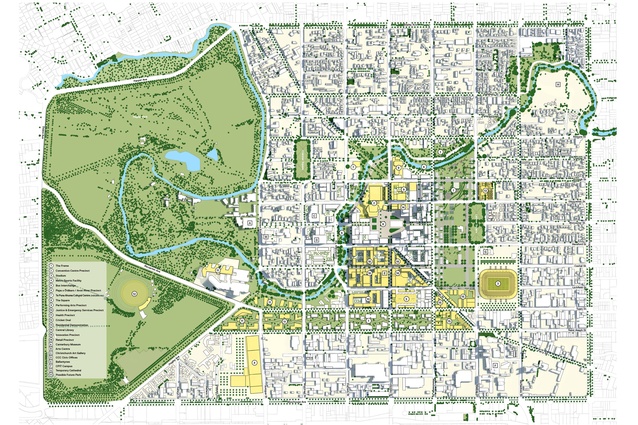Editorial: Chris Barton on rebuilding Christchurch
“From the information we had, and the advice we got, trying to take into account all of the precedents we were setting, I think we did the best we could.” On the 10th anniversary of the devastating Ōtautahi Christchurch earthquake of 22 February 2011, former National Prime Minister Sir John Key’s assessment in the New Zealand Herald of his government’s handling of the city rebuild is dispiriting, to say the least. So much for a market-led recovery.
Clearly Key didn’t watch film-maker Gerard Smyth’s outstanding documentary When a City Rises, screened on TVNZ to coincide with the anniversary. It is a poignant celebration of what people power and community can achieve in the face of adversity but also a searing indictment on the job Key’s government did.
As the documentary vividly shows, the government received plenty of really good advice on what to do from a variety of people, notably the ‘Share an Idea’ urban planning community-involvement exercise. It offered more than 100,000 suggestions, which were then incorporated into Christchurch City Council’s Christchurch Central Recovery Plan, which the government mostly ignored.
Imagine what the city might have been by now had the government accepted recommendations for a light rail system to be established between the city centre and the airport. Several parts of When a City Rises show what Christchurch was like when it had a bustling public transit utility revolving around Cathedral Square and how that all disappeared as the car took over in the ’60s. But, under a Key government intent on building lots of roads, public transport was a dirty word.
There was also a proposal for Christchurch to have New Zealand’s first District Energy Scheme (DES) providing electrical energy, heating and cooling from a centralised plant fuelled by sustainable energy sources. Imagine how good Christchurch might have looked now in terms of being a low, perhaps zero, carbon-emissions city had such a scheme been implemented. The Key government’s record on climate change was never inspiring.
What Christchurch got instead in 2012 was a top-down, government-imposed ‘Blueprint’, famously developed in 100 days, which, it has to be said, really wasn’t very good. At its launch, Key insisted the plan would lead to Christchurch becoming the most liveable city in New Zealand. In February’s Herald article, Key believes early visions to realise that aim have transpired.
He cites The Terrace and Riverside Market developments along the banks of Ōtākaro Avon River, along with other big private initiatives, as prime examples of progress. Which is a bit rich because, as Smyth’s documentary demonstrates, such development mostly happened despite the Blueprint, not because of it.
As many at the time pointed out, although much was made of the so-called Green Frame of the Blueprint, which made the central area of the city more compact, it turned out to be a massive government land grab, which seemed to be about limiting the amount of buildable land, keeping property values high. The compulsory acquisition also actually kyboshed spontaneous private property owners’ redevelopment plans already under way.
Smyth’s documentary shows, too, how the 70 per cent demolition of the city led property owners into a frenzy of extracting insurance settlements, and that many took their funds to invest in new opportunities outside of Christchurch.
In essence, the Blueprint revolved around specialist precincts and various anchor projects dedicated to business or government activities, such as health and justice services, a convention centre and a stadium.
As Morten Gjerde points out in his 2017 article, ‘Building Back Better: Learning from the Christchurch Rebuild’, precinct planning or zoning is a very dated curiosity of the modernist approach to land-use management and has largely been discredited because it promotes a land-use monoculture that often leaves different parts of the city extremely quiet at times.
He cites the proposed stadium as a likely dead environment and notes that the convention centre and stadium are conceived at scales that serve national rather than local agendas. “The physical scale of these projects in the city centre conflicts with the permeable, walkable scale envisaged elsewhere in the plan.”
When a City Rises delivers a more blunt assessment – that the delayed $475m Te Pae Christchurch Convention Centre is too large, in the wrong place and very much in danger of being underused and becoming the city’s white elephant.
In these COVID times, when the prospect of a return to frequent global travel seems to reside in a distant future, one could predict a similar fate for other convention centre projects, such as Auckland’s and Wellington’s.
But while ongoing delays in many of the anchor projects highlight how the Blueprint has slowed the rebuild down, When a City Rises is not all bleak. There’s the elation of the people fighting back, saving and restoring Warren and Mahoney’s brutalist, acoustically world-class Christchurch Town Hall, the adored Margaret Mahy Playground, the sense of belonging engendered by the Tūranga Central Library and the against-the-odds, magnificent heritage restoration of The Arts Centre.
The highlight is giving voice to Ngāi Tahu’s statutory role in the rebuild. The discussion of the Ōtākaro Avon River – “an iconic, uniform width and depth drain” – followed by an example of how the river might be re-imagined using Ngāi Tahu values and narratives, is a beacon of hope.
When a City Rises shows a government, in the form of the Canterbury Earthquake Recovery Authority (CERA), both incapable and unwilling to engage effectively with a public that was ready, able and willing to be involved. Ultimately, that’s not just a failure of imagination but a failure of leadership.










